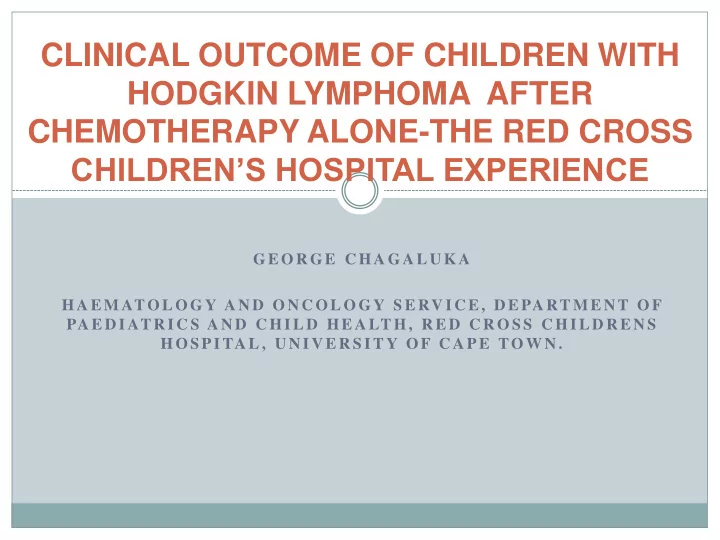

CLINICAL OUTCOME OF CHILDREN WITH HODGKIN LYMPHOMA AFTER CHEMOTHERAPY ALONE-THE RED CROSS CHILDREN’S HOSPITAL EXPERIENCE G E O R G E C H A G A L U K A H A E M ATO L O G Y A N D O N C O L O G Y S E RV I C E , D E PA RT M E N T O F PA E D I AT R I C S A N D C H I L D H E A LT H , R E D C R O S S C H I L D R E N S H O S P I TA L , U N I V E R S I T Y O F C A P E TO W N .
INTRODUCTION Majority of children and adolescents with classical HL are likely to be cured. Current strategies are directed at limiting adverse effects. Hybrid regimes have been developed . Lower cumulative doses of alkylators, doxorubicin and bleomycin. Red Cross Children’s Hospital adopted the UKCCSG ChlVbPP/ABVD protocol in 2005. This study is a review since the protocol was adopted.
OBJECTIVE To assess the efficacy of standardised hybrid chemotherapy for Hodgkin lymphoma
METHODOLOGY Retrospective document review Thirty five children with HL treated between 2005-2012 Patients received alternating ChlVbPP and ABVD Stage 1: 2 courses of each Stage 2-4: 3 courses of each Relapsed or refractory patients were treated with EPIC +IFRT Autologous stem cell transplantation was reserved for poor responders after 4 courses of EPIC
TREATMENT PROTOCOL ChlVbPP to alternate with ABVD every 28 days Chl Chlorambucil 6mg/m²/day PO on days 1-14 Vb Vinblastine 6 mg/m² (max 10mg) IV push on day 1 and 8 P Procarbazine 100mg/m²/day PO on days 1-14 P Prednisolone 40mg/m²/day PO on days 1-14 A Doxorubicin 25mg/m² on days 1 and 15 B Bleomycin 10,000units/m² IV push on days 1 and 15 V Vincristine 1.5mg/m² IV push on days 1 and 15 D Dacarbazine 375mg/m² IV push on days 1 and 15
RESULTS Patient characteristics 1. Variable Number Percentage Age (years) < 6 7 20 6-12 17 48.6 12- 18 11 31.4 Sex Male 25 71.4 Female 10 28.6 HIV Infected 2 5.7 Uninfected 33 94.3 Stage 1 7 20 2 10 28.6 3 7 20 4 11 31.4
2. Disease characteristics Variable Number Percentage Primary site Cervical 25 71.4 Mediastinal 6 17.1 Supraclavicular 4 11.4 Presence of B symptoms Yes 18 51.4 No 17 48.6 Histology Nodular sclerosing 22 62.9 Mixed cellularity 9 25.7 Lymphocyte predominant 3 8.6 Lymphocyte depleted 1 2.9 Bulky disease Yes 14 40 NO 21 60 Bone marrow involvement Yes 7 20 No 28 80
3. Current Status 8 Thirty (85.7%) patients are still alive including 2 lost to follow up in remission. Six (17%) patients relapsed 2 Stage 3 patients - both salvaged 4 Stage 4 patients – only 1 could be salvaged Three of the six relapses (50%) were salvaged Four (11.4%) patients died 3 relapsed Stage 4 and 1 refractory Stage 4 patients
4. Overall survival (OS)
5. Event Free Survival (EFS)
DISCUSSION 11 Good overall survival (OS) for stage 1, 2 and 3. Good event free survival (EFS) for stage 1 and 2. Patients who relapsed were likely to have: Stage 4 disease (p=0.008) B symptoms (p=0.011) Bone marrow involvement (p=0.006). All the patients who died and all but one of the relapses had Nodular sclerosing histology. Treatment was well tolerated with few acute toxicities.
CONCLUSION 12 Single treatment modality using chemotherapy alone is effective for Stage 1, 2 and 3 disease . Stage 4 disease requires earlier evaluation to detect poor responders or patients with refractory disease, with a view to changing protocol.
ACKNOWLEDGEMENTS 13 Prof A. Davidson Dr M. Hendricks Dr A. Van Eyssen Children with cancer Nurses and Doctors at Red Cross Parents and guardians
Recommend
More recommend